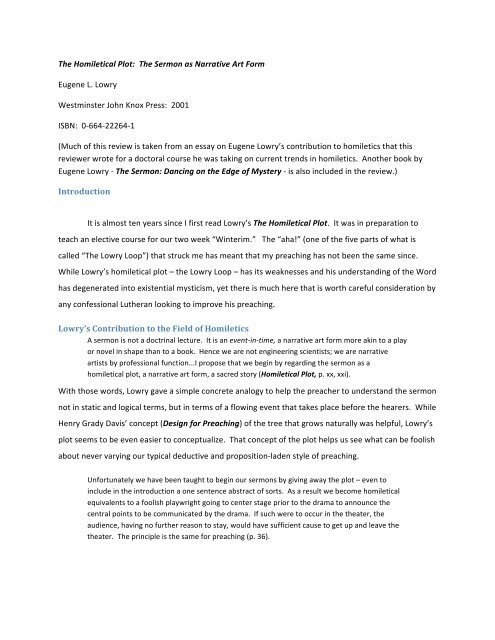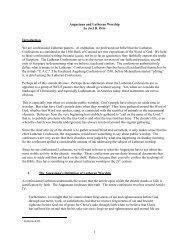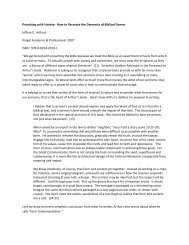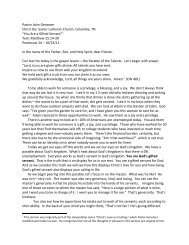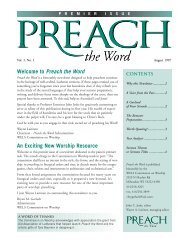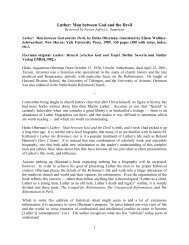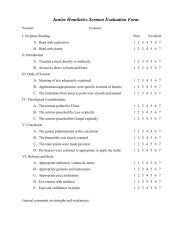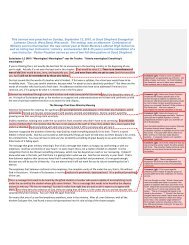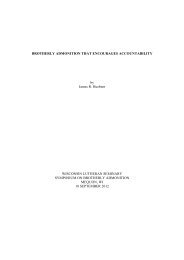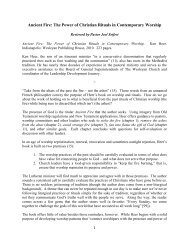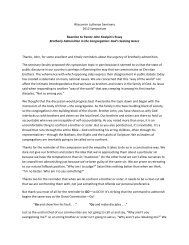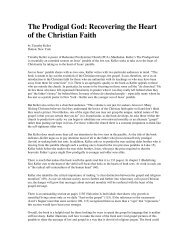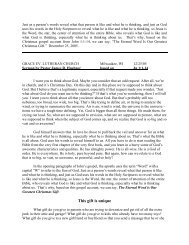The Homiletical Plot: The Sermon as Narrative Art Form - Wisconsin ...
The Homiletical Plot: The Sermon as Narrative Art Form - Wisconsin ...
The Homiletical Plot: The Sermon as Narrative Art Form - Wisconsin ...
You also want an ePaper? Increase the reach of your titles
YUMPU automatically turns print PDFs into web optimized ePapers that Google loves.
A second key contribution w<strong>as</strong> pointing out the all too common lack of penetrating analysis in preaching the law. All too frequently we don’t get to the motivational heart of the presenting problem of sinful man which the text holds before us. Unfortunately, the greatest single weakness of the average sermon is the weakness of diagnosis. What is lacking is concrete perceptive insights into the multi-‐faceted ambiguities of the human situation which, when revealed, make one reflect: “Of course, why didn’t I think of that?” or “Yes, I have always known that without knowing how to say it.” (p. 41). <strong>The</strong> specific tool Lowry urges us to use to accomplish this analysis is the relentless <strong>as</strong>king of “Why?”(p. 47). As we keep <strong>as</strong>king “Why?” we move deeper to the real heart of the matter. Once we have discovered the real problem in very concrete terms, then we will also know how to apply the real answer of the gospel in fitting (and varied!) concrete terms. <strong>The</strong> third contribution of Lowry’s narrative sermon form is it’s backbone of “itch” and “scratch” that Lutherans will recognize <strong>as</strong> an artful way to speak of the law/gospel dichotomy and tension of the text. Every explicit theme presumes an implicit problem; every explicit problem presumes an implicit theme. When this does not hold, there is no sermon! In the tension produced by the interaction of these ingredients, sermons are born. <strong>The</strong> felt bind between need and theme is central to sermonic form; discovering it is the chief work we do in transforming vague Sunday morning thoughts into a generative sermon idea (p. 19). Care must be exercised not to do this in a superficial manner (thereby perpetuating what David Schmitt h<strong>as</strong> called our law/gospel obsession). However, because this law/gospel tension is at the heart of the Lowry loop, Lutheran p<strong>as</strong>tors will not feel <strong>as</strong> if they have abandoned the essence of their homiletical training or have moved outside the boundaries of our theology. This makes Lowry’s homiletical plot an e<strong>as</strong>ier first step for many a Lutheran p<strong>as</strong>tor – and seminary student -‐ to move into the realm of more narrative preaching. <strong>The</strong> final contribution of Lowry’s narrative form is the concrete nature of the Lowry Loop itself. It provides those new to more inductive/narrative preaching an e<strong>as</strong>ier entry point into trying out a sermon in a more narrative style. A Lutheran looking at the Lowry Loop would perhaps characterize the Lowry Loop <strong>as</strong> a one part law/gospel sermon. Here are the five parts of the Lowry Loop with brief explanation: • Oops! (Upsetting the equilibrium): <strong>The</strong> preacher begins by getting the congregation off balance by introducing the problem/challenge/question that is at the heart of the
text without giving it away. Something important in our lives/hearts is not <strong>as</strong> it should be. • Ugh! (Analyzing the discrepancy): Here the preacher allows the problem/challenge/question of the text to get worse before a resolution is revealed. <strong>The</strong> preacher probes to the heart the problem (going beyond mere symptoms) by <strong>as</strong>king “why?” and allowing all human answers to the dilemma of human sin to prove themselves to be the dead ends that they are. • Aha! (Disclosing the clue to resolution): Once the congregation h<strong>as</strong> seen that all our logical and re<strong>as</strong>onable human answers to the text’s malady are hopeless, suddenly the gospel breaks in. Since the gospel is something neither eye h<strong>as</strong> seen or ear h<strong>as</strong> heard or mind h<strong>as</strong> conceived (1 Corinthians 2), it tends to break in with a counterintuitive force. <strong>The</strong>re is a “Eureka!” moment. • Whee! (Experiencing the Gospel): This flows right out of the Aha! (which is really only the brief moment of sudden realization that God h<strong>as</strong> another answer in Christ!). <strong>The</strong> gospel is now proclaimed to answer the malady of the text. • Yeah! (Anticipating the Consequences): <strong>The</strong> original problem/challenge/question is now seen through the eyes of the gospel in a whole new light. If it is a text of appropriation the gospel is celebrated here in the presence of the people. If it is a text of application the implications for life are traced out. Cautions about Uncritically Adopting Lowry’s Methods Yet with all the positives of Lowry’s narrative form, a careless embrace of Lowry’s method would be <strong>as</strong> foolish for a Lutheran preacher <strong>as</strong> writing him off or ignoring him. <strong>The</strong>re are two concerns this reviewer sees. One is to think that we have finally found the method that magically transforms our preaching with an e<strong>as</strong>y five-‐step template. At times, Lowry himself seems a bit too certain that carefully adhering to the homiletical plot cannot help but return the desired results. “If we just could transform our intuitions into articulate form regarding what it is that happens in our best preaching, we could cause it to happen” (p. xix-‐ emph<strong>as</strong>is author’s). While it could be argued that Lowry is speaking more of the product (a good sermon) than the result (changed listeners), this reviewer is not convinced that Lowry always makes that distinction so clearly. <strong>The</strong>re is no magic sermonic form that makes the offense of the cross disappear.
To be fair, in <strong>The</strong> <strong>Sermon</strong>: Dancing the Edge of Mystery, Lowry much more disavows such a mechanical working of his method. Yet in the process he replaces one problem with a much greater one. In that book, Lowry reveals an existential, almost mystical, view of the working of the Word. Lowry dangerously confuses the subjective reception of the Word by the heart of the hearer with the objective power of the Word. His false dichotomy is that we can preach, but we never know when the powerful moment of proclamation is going to show up. It happens somewhat serendipitously. That is the mystery on whose edge you dance. Preaching I can do. I choose it; I prepare it. Prayerfully I engage it, and I perform it. I do it. I will do it Sunday next. Proclaiming the Word is what I hope will happen next Sunday. I will attempt my preparation strategy in such a way <strong>as</strong> to maximize the chance for it. But proclaiming the Word? Nobody h<strong>as</strong> the grip of control for it. You cannot capture it; you cannot possess it; you cannot package it; you cannot deliver it, and you cannot control the receipt of it (p. 37). His l<strong>as</strong>t statement is most definitely true: the subjective reception of the gospel proclaimed by the human heart is utterly out of our control. That rests entirely in the hands of the Holy Spirit. But the statements leading up to that are utterly false. God h<strong>as</strong> given us a “grip” on himself by binding himself to his means of grace. Proclaiming the gospel is not a “hope” in our worship on Sunday morning, unless we ignore the gospel. It is a certainty on which we can joyfully rely! <strong>The</strong> subjective response is indeed something for which we hope and pray. While the new homiletic h<strong>as</strong> returned to preaching biblical texts, the effects of the historical critical method still have robbed them of objective confidence. As Lowry and others ridicule propositional preaching, often it is the concept of propositional truth itself that is the object of their scorn. Paul Scherer is clear (?): “A meeting h<strong>as</strong> to take place.” He senses a divine “relentless moving in upon our lives.” God “is not intent on sharing conceptual truth (!),” Scherer explains. “That must come later. It is not some saving me<strong>as</strong>ure of information he wants to impart; it is himself he wants to bestow” (p. 29). It is not God in the form of his bare essence who must draw near to us to save us. It is rather God through his powerful Word who is constantly drawing near to us. Perhaps an “Aha!” is necessary for Eugene Lowry from Paul’s words in Romans 10, “Do not say in your heart, ‘Who will <strong>as</strong>cend into heaven?’ (that is, to bring Christ down) or ‘Who will descend into the deep?’ (that is, to bring Christ up from the dead). But what does it say? ‘<strong>The</strong> word is near you; it is in your mouth and in your heart,’ that is the Word of truth we are proclaiming.”
It is especially this <strong>as</strong>pect of Lowry’s methodology that gives me pause <strong>as</strong> I preach his style and teach others to do the same. In fact, it is Lowry himself who issues the warning in <strong>The</strong> <strong>Sermon</strong>. Browne identifies a central issue that lies underneath our current concern about sermonic language – indeed notes a confusion regarding homiletical communication. “What a person believes about the mode of divine revelation should determine the mode of… [one’s] preaching,” he observes. Preachers who believe that divine revelation is given in propositional form will, of course, develop sermons that correspond to that view. Inspiration would consist of “being given the right propositions” for use in the preaching occ<strong>as</strong>ion….Notice the implications here. If you are a biblical literalist, likely you will not be greatly interested in homiletical acts of evocation. You will simply repeat what you believe God said – and that’s the end of the matter. Mystery no more; it is swallowed up by absolute knowledge. It is all very consistent (p. 40-‐41). Yet this is “all very consistent” only if we accept the caricature by which Browne and Lowry set up a straw man and then proceed to knock him down! Do we believe that God reveals himself in “propositional form”? Yes. Read many sections of the Apostle Paul’s letters, if you doubt that! Do we believe that God only reveals himself in propositional form? Of course not! God did not lay a proposition in the manger but himself – though we can state with confidence many wondrous propositions about that awesome incarnation! What is more, even we “biblical literalists” (argumentum ad hominem!) are not so foolish <strong>as</strong> to actually teach that just because proposition is one way God h<strong>as</strong> revealed himself to us, therefore it is the only way we can preach! We believe it is the duty of systematic theology to delineate for us clearly and distinctly the propositions that summarize the truth of what God h<strong>as</strong> revealed. Such work of the systematician helps supply confidence and clarity for carrying out the t<strong>as</strong>k of preaching and teaching. It is then the t<strong>as</strong>k of homiletics to proclaim those truths to God’s people by re-‐clothing them in forms <strong>as</strong> many and varied <strong>as</strong> the Scriptures. Perhaps I should not be so frustrated with Lowry for setting up this straw man and then knocking him down. All too often, our own careless theologizing and preaching h<strong>as</strong> set up this very straw man, daring our critics to knock him down.


